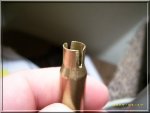So, has anybody had much success determining the proper COL in their particular rifle, with a particular bullet by simply taking a once-fired brass from your chamber, and before resizing it, placing a bullet into the neck as far out(long) so the case neck just barely holds the bullet with enough tension to allow it to be pushed into the cartridge when carefully chambered. After doing so, remove the cartridge carefully and measure COL, in hopes that the rifling lands would have contacted the bullet and in theory seated it to have the least amount or proper amount of "jump". Take a measurement of the COL, and use this as a precise starting point?
I'm still trying to work my head around the proper and most precise way to determine bullet seating depths in accordance to the rifling lands and the amount of jump in a bolt action rifle. I know I'm probably over-thinking this.
I'm still trying to work my head around the proper and most precise way to determine bullet seating depths in accordance to the rifling lands and the amount of jump in a bolt action rifle. I know I'm probably over-thinking this.


